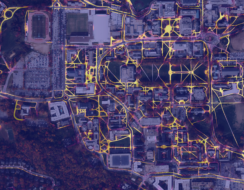Wyvern has received a CAD $4M (~$3.2M) investment from STDC, just weeks after the Canadian satellite imaging startup announced a $4.5M seed round and its inclusion in Y Combinator’s Winter 22 (W22) batch.
STDC, or Sustainable Development Technology Canada, is an “arm’s-length” foundation funded by the Canadian government. STDC’s grant is non-dilutive and tied to a three-year project to reduce Canadian agriculture emissions. Canada’s ag sector makes up for 8.4% of the country’s greenhouse gas emissions.
MaC Venture Capital led Wyvern’s seed round, announced on Jan. 17, joined by Carvalho Capital, Gaingels, the Canadian government, Liquid 2 Ventures, Soma Capital, and Unpopular Ventures.
Wyvern 101: The Canadian startup is developing high-resolution hyperspectral imaging sensors that will unfold from space telescopes. Thanks in part to proprietary deployable optics technology, Wyvern says its hyperspectral imagery will cost 100X less than that of satellites using traditional telescopes.
Wyvern’s founding team: Wyvern cofounders helped build Alberta’s first satellite while they were students. The 50/50 gender split among the four cofounders—and a 66% female exec team—is especially notable. “Diverse teams perform better. The fact is I get perspectives from people that think differently than I do,” Wyvern CEO Chris Robson told Payload.
Market research: Wyvern interviewed 50–100 potential customers, Robson estimated, and came to a few realizations.
- Historically, “there have been a number of blockers to getting hyperspectral from space,” including satellite size, telescope constraints, and bandwidth bottlenecks.
- The space engineers-turned-founders wanted to build a climate-focused product and “recognized all the potential environmental benefits” of hyperspectral.
- “If we took a chemical picture of earth every day…we could provide a baseline [understanding] of what Earth’s health is.”
Thus, a startup was born. To understand what Wyvern has set out to do, “the best comparison is probably synthetic aperture radar,” Robson said. SAR startups like ICEYE and Umbra “are building these big radar antennas that unfold from their satellites, from very small platforms that are a lot cheaper than the way things were done traditionally.”
Earth observation and the space industry writ large are “finding ways to become far more capital-efficient, getting the same or even more quality out of the product they’re delivering,” Robson said. The cost curves of satellite buses and downlink, to name just two examples, have come down considerably in recent years.
Wyvern’s first DragonEye satellites equipped with the deployable optics technology are set to launch in the next few years. Robson couldn’t share additional details about the launch provider, as the contract is wrapped up in NDAs
On being in YC W22: “It’s been a different atmosphere from what you would experience…in the space sector,” especially in the approach to scaling a business. “Space has its own culture…largely driven by a lot of government program cultures over the last 50 years.” Space has also traditionally been a hardware business, “where a natural barrier of entry is getting off of Earth.”
- The best practices of software startups “can be translated over to hardware and space business,” Robson said. “I think that’s a really good thing.
- “We’re learning how to be a run-of-the-mill commercial industry,” rather than a top-down, exclusively government-funded one.
Use cases: Wyvern’s “beachhead market is agriculture,” Robson said. “We can help minimize the amount of inputs that go into farming and the results of excess inputs.” Wyvern also sees a target marked in ESG-focused Fortune 500 programs, from environmental remediation to monitoring the change in forests.
- Wyvern’s “imaging products are going to help farmers use less fertilizer, pesticides, and water and help produce bigger yields,” STDC President and CEO Leah Lawrence said in a statement.
+ Closing thoughts: Part of Wyvern’s goal is to help develop a robust Canadian space sector. After all, the comparisons between life in Canada and operating in space flow freely: “We work in remote environments with very extreme environmental conditions, with high-precision machinery that we design and build. And we do a lot of resource extraction,” Robson said.
“We’re a big country that relies on space,” Robson concluded. “Canada’s really well-positioned to do things in space and be really great at it on the international stage.”




